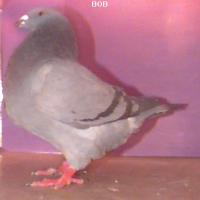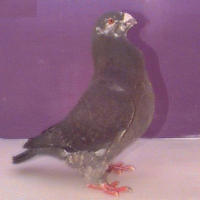

| The Breeds of the United States | ||||||
Giant HomerOne of just a few truly "American" breeds, the American Giant Homer was first recognized as a distinct breed by the NPA (National Pigeon Association) at the 1928 Grand National Show. The breed is the result of an attempt by early breeders of squabbing homers to improve their breed both commercially and aestheticallyThe breed is known for its large size and suitability for production. It makes you pause mid-step when first seen, wondering if you’ve just seen a pigeon crossed with a bodybuilder. The American Giant Homer is all about presence. It is large, barrel chested, and muscular looking, holding its wings tight to the chest. It is a handful and more. It takes both hands to comfortably hold this pigeon. There’s something regal—almost aristocratic—about the way an American Giant Homer stands, with chest out and back straight. Yet, underneath that robust exterior lies a personality that couldn’t be gentler. Their feathers come in nearly every shade and pattern available in the pigeon breeding hobby. Their eyes are a bright glowing red/orange with deep black pupils. It available in a wide array of colors, including; blue, silver, black, ash-red, red, yellow, brown, grizzle, mottled, Almond, Andalusian and the list goes on. |
||||||
HistoryWhile the development of most breeds of pigeons are set in antiquity, not so with the American Giant Homer. In fact, many of the people involved in the development of this breed are known by name. The first strains of Giant Homers were begun by two early breeders, R.W. Keene and Wm. P. Gray in the year 1918. This "documented date" was only the continuation of their breeding work which had really started some years before 1918. Gray worked to produce a strain of pure white Giant Homers. They were bred from big, white, flying Racing Homers. Giant Homers that Keene produced were from Racers and English Show Homers. By 1922, the first year that the Giant Homer was classified as one of the top utility breeds, its specific National Show Class was called the Jumbo Squab Homer, and was divided into seven color classes: White Jumbo Homers, Black Jumbo Homers, Blue or Silver Jumbo Homers, Red or Yellow Jumbo Homers, Black or Blue Cheques, Red or Yellow Cheques, and AOC Jumbo Homers.Early on, great emphasis was always put on production of squabs, both by numbers produced per pair and total yearly weight. In 1933, Giant Homers won the New Jersey State Squab Breeding Contest with 30 pens competing with 10 other breeds. This was won with the highest production ever attained in any squab raising contest. Results for each month's efforts were published in Frank Hollmann's American Pigeon Journal Later Carl Graefe, Irvin Goss, and Ed Blaine transformed the breed from being an oversized flying homer to a blocky short-feathered really big bird. More color types were also bred into the breed by Gerhard Hasz and George Steams, including "Dual-colored" (auto-sexing), a variety also found in the Texan Pioneer. Hasz and Steams promoted colors and used technical terms such as homozygous and sex-linked until everybody got used to using genetic knowledge in the further development of the breed to what we see today. |
||||||
Gallery |
 |
 |
 |
|||
Standards |
2000 | 1977 | ||||